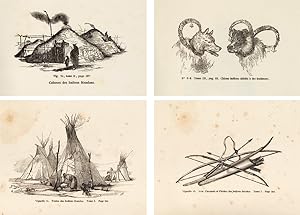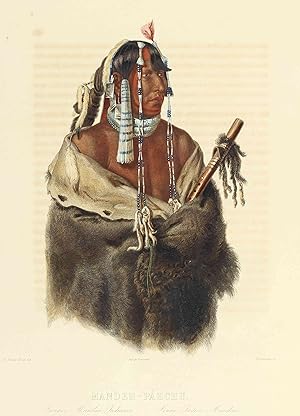Maximilian Wied Neuwied Prinz Alexander Philipp (2 results)
Product Type
- All Product Types
- Books (2)
- Magazines & Periodicals
- Comics
- Sheet Music
- Art, Prints & Posters
- Photographs
- Maps
- Manuscripts & Paper Collectibles
Condition
Binding
- All Bindings
- Hardcover (1)
- Softcover
Collectible Attributes
- First Edition (1)
- Signed
- Dust Jacket
- Seller-Supplied Images (2)
- Not Print on Demand (2)
Free Shipping
- Free US Shipping
Seller Location
Seller Rating
-
VOYAGE DANS L'INTERIEUR DE L'AMERIQUE DU NORD, EXECUTE PENDANT LES ANNEES 1832, 1833 ET 1834.
Published by Arthus Bertrand, Paris, 1843
Seller: William Reese Company - Americana, New Haven, CT, U.S.A.
Three volumes. [4],383; [4],487; [4],410pp., plus sixty engravings on thirty plates, and a map of Fort Clark. Lacks the folding map. Half title in each volume. Contemporary three- quarter green morocco and cloth, gilt. Minor wear to extremities. Scattered foxing, moderately heavy at times. Very good. First French edition of this most important work of Western Americana, describing the travels of German Prince Maximilian of Wied in the United States and on the upper Missouri River in 1832-34, accompanied by Swiss artist Karl Bodmer. Prince Maximilian was already an experienced naturalist and explorer in 1832, having made an important scientific expedition to Brazil in 1815-17. His preparations for his trip to North America included retaining Karl Bodmer to prepare illustrations of the journey. Arriving in the fall of 1832, the Prince travelled across Pennsylvania and the Midwest and ascended the Missouri River in the spring of 1833. He went as far upstream as the American Fur Company post of Fort Mackenzie in present-day Montana, and spent the winter at Fort Clark, near the Mandan Indian villages. During this prolonged stay, he and Bodmer had ample opportunity to observe the Indian tribes of the upper Missouri in their full glory, carefully recorded by Bodmer in watercolors. In the spring of 1834 they returned to Europe, and devoted the next five years to preparing the text and plates for this publication. Often eclipsed by the famous Bodmer atlas of the expedition, Maximilian's text remains one of the most important western travel narratives of the fur trade era, and a rare book in its own right. WAGNER-CAMP 76:2. HOWES M443a. EBERSTADT 113:508. CLARK III:115. RADER 3652 (ref). PILLING, PROOF-SHEETS 2522. SABIN 47015.
-
Reise in das Innere Nord-America in den Jahren 1832 bis 1834.
Published by J. Hoelscher, Coblenz, 1839
Seller: Milestones of Science Books, Ritterhude, Germany
Book First Edition
Hardcover. Condition: Near Fine. 1st Edition. Two parts in two volumes. Coblenz: J. Hoelscher, 1839-41. 4to (348 x 268 mm). xvi, 653 [3]; xxii, [2] , 687 [1] pp. Bound with the text and protected by tissue paper are 33 aquatint plates ("vignettes") after Karl Bodmer (numbered vig. I- vig. XXXIII except for plate XXVI =unnumbered), heightened with gum arabic and with the blind-stamp "C Bodmer / Direct", a total of 52 woodcut text illustrations; vol. I with a large folding engraved map partially coloured in outline bound before title; vol. II with 12 pp. list of subscribers, a lithographed plate of Fort Clark bound after p. 70, one small lithographed key plate (to plate XXI) bound after p. 686 and a folding meteorological table bound at end, errata leaf in each vol. Uniformly bound in contemporary German half mottled calf and marbled paper over boards, each spine with gilt decoration and gilt-lettered labels, red-sprinkled edges (minor wear to extremities and rubbing to boards, corners slightly bumped, spines scratched). The text exceptionally bright and crisp, the preliminary pages with list of subscribers and title as well as the appendix in vol. II somewhat browned, the vignette plates mostly with minor even yellowing and light offsetting of text mostly on plate versos, occasional minor finger-soiling, the large folding map backed by thin linen and somewhat creased. Provenance: Chateau Tetschen library of the counts of Thun-Hohenstein (red coat of arms stamp to verso of titles). ---- FIRST EDITION, FIRST ISSUE OF THE FINEST WORK ON AMERICAN INDIAN LIFE AND THE AMERICAN FRONTIER, which includes the first truly accurate depictions of the Plains Indians, the result of an epic journey which took place at a time when the mass migration of settlers and pioneers was about to alter irrevocably the unspoiled West. Prince Maximilian's text was first issued in German in 20 parts from 1838 through 1841, with an abridged English translation being issued in London by Ackermann in 1843. Karl Bodmer (1809-1893) was engaged by Prince Maximilian (already famed for his earlier explorations to Brazil) to record of his travels among the Indian people of North America from 1832 to 1834, at a time when the Plains and the Rockies were still virtually unknown. His efforts show great versatility and technical virtuosity and give us a uniquely thorough, accomplished and detailed picture of a previously little understood (and soon to vanish) way of life. The most important part of their travels started from St. Louis, whence they proceeded up the treacherous Missouri along the line of forts established by the American Fur Company. At Bellevue they encountered their first Indians, then went on to make contact with the Sioux tribe, learning of and recording their little known ceremonial dances, their powerful pride and dignity. Transferring from the Yellow Stone to another steamer, the Assiniboine, they continued to Fort Clark, studying there the Mandan, Mintari and Crow tribes, then the Cree and Assiniboin tribes at Fort Union, the main base of the American Fur Company. On a necessarily much smaller vessel they journeyed through the extraordinary geological scenery of that section of the Missouri to Fort Mackenzie in Montana, establishing over a month there a cautious friendship with the fearsome Blackfoot tribe. From this, the westernmost point reached, it was considered too dangerous to continue and the return journey downstream began. The winter brought its own difficulties and discomforts, but Bodmer was still able to execute numerous studies of villages, dances, and especially, the people, who were often intrigued and delighted by his work. The portraits are particularly notable for their capturing of individual personalities, as well as forming, together with Prince Maximilian's written studies, the primary accounts of what became virtually lost cultures. . . . - Visit our website for further reading and images!.



